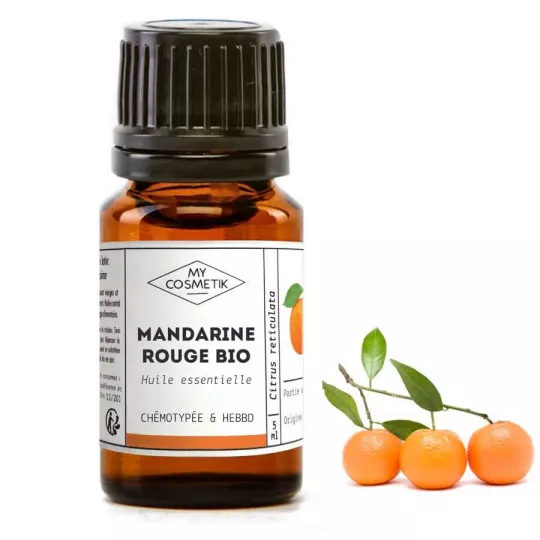Organic Red Mandarin Essential Oil (AB)
Mandarin essential oil is, like that of many citrus fruits, rich in limonene. In olfactotherapy, it is soothing and promotes sleep. Its citrus fragrance is particularly appreciated by children.
Our organic labels: ORGANIC & HEBBD essential oil, from Organic Farming (AB) controlled and certified by ECOCERT France SAS FR-BIO-01.
Rich in limonene, mandarin essential oil is very close in terms of chemotype, precautions for use and properties to sweet orange essential oil. Red mandarin essential oil is particularly appreciated for its safe use for the whole family whatever the method of use. However, it must be diluted in a vegetable oil before applying to the skin. The color of the mandarin (green, yellow, orange or red) corresponds to the different stages of maturation of the fruit: first green, the mandarin will then be yellow and finally orange or red. However, we are talking here about the same fruit, coming from one and the same tree: Citrus reticulata blanco var mandarine.
Cosmetic properties:
Mandarin essential oil is, like that of many citrus fruits, rich in limonene. In olfactotherapy, it is soothing and promotes sleep. Its citrus fragrance is particularly appreciated by children.
Carefully selected by our quality department, each batch is scrupulously analyzed, controlled (geographic origin, appearance, physicochemical criteria) and chemotyped in order to guarantee a constant and maximum concentration of aromatic molecules and active ingredients.
Organoleptic properties:
Botanical name: Citrus reticulata
Part of the plant used: fruit pericarp
Origin: Italy, Brazil
Color: orange to dark red
Odor: characteristic, that of tangerine zest
Culture: organic farming
Extraction method: cold expression of the fruit pericarp (our essential oil contains all of the aromatic principles of the plant), extracted without solvent, non-terpenated.
Botanical family: Rutaceae
Yield: 0.28 to 0.31%. This means that it takes 322 to 357 kg of red mandarin peel to obtain 1 kg of red mandarin essential oil. Yield may vary depending on season, region, type of crop, or from one year to the next. The lower the yield, the more valuable and expensive the essential oil will be.
Solubility: All essential oils are soluble in oil or oily raw materials. To mix an essential oil in water, it must first be dissolved in a dispersant such as Disper.
Storage: away from light and heat.
Keep out of reach of children.
Always close the bottle correctly.
Precautions for use:
Do not use in pregnant or breastfeeding women.
Do not use in children under 8 years old.
Dermocaustic: to be diluted heavily in a vegetable oil when used cutaneously.
Photosensitizing: no exposure to the sun within 6 hours following application.
Follow the precautions for using essential oils.
For any use of essential oils for therapeutic purposes, consult a doctor.
The information given on the site does not constitute a prescription, it remains data for informational purposes, it does not engage our responsibility in any way.
The following text, known properties, examples of use and routes of administration are general information taken from authoritative bibliographies in the field of essential oils and aromatherapy.
In general, do not use pure essential oil on the skin or mucous membranes. Essential oils should not be applied to the eyes, around the eyes, or in the ears.
Once the user has seen at least one product this snippet will be visible.
